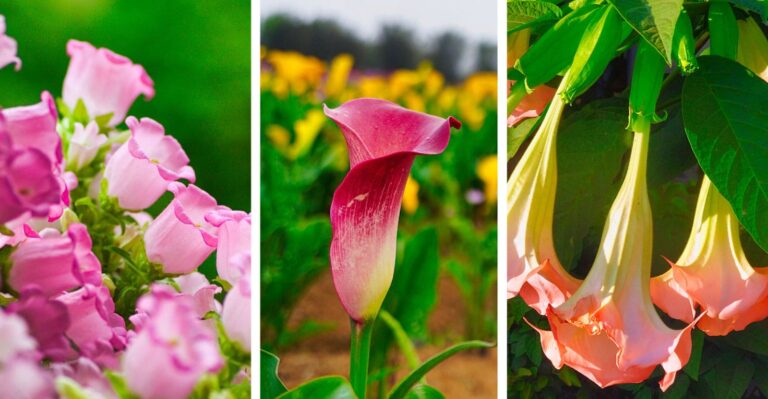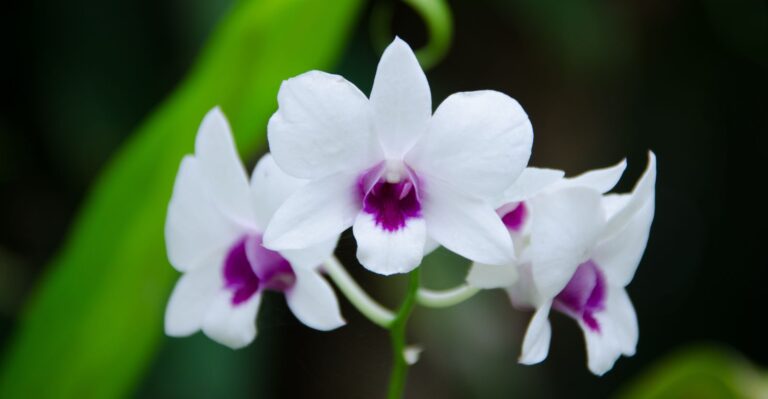Amazon has put together some great Home Gift Deals – save money and get your shopping done at the comfort of your home! Click here to see deals on Amazon
The Alocasia Pink Dragon is a gorgeous garden plant that thrives in tropical environments, and people like to grow it as it’s effortless to maintain. The leaves come in various colors, and the flowers can be orange or yellow, giving them a lovely look.
This stunning plant is ideal for people who like to keep their homes colorful and tropical, but it also makes a beautiful addition to a tropical garden. To help you maintain the alocasia pink dragon in its prime form, I’ve included all the information in this detailed guide that you need to know.
Some Products at Amazon to Grow Alocasia Pink Dragon
What is Alocasia Pink Dragon?
It’s a tropical plant that has gained popularity in recent years, and there’s good reason for that. The alocasia grows into a stunning, dramatic plant with thick, lush leaves on a colorful stem. This beautiful plant belongs to the Araceae genus, containing several thousand other species.
Origin: This is a tropical plant native to South-East Asia, the Philippines, and the South Pacific Islands as it loves the high humidity and plenty of light. If you’re in America, it grows best in the USDA Zones 10–12.
Appearance: It has arrow-shaped, lobed leaves with light green veins growing on a pink stem. The underside of the leaves features a distinctive burgundy color. The leaves can grow up to 18–20 inches long in the right environment.
It grows a single leaf at each stem, and when the old leaf falls off, new leaves appear. The pink dragon plant sprouts from a bulb, and when appropriately cared it can grow up to 4 feet tall and spread up to 85 cm wide.
It blooms a flower that is orange outside but can be reddened to some degree over the summer. But flowering isn’t the main attraction of this plant, but it’s essential to develop seed pods for propagation.
Other names: It’s also known as Elephant Ears Pink Dragon and Alocasia Baginda Pink Dragon
How to care for alocasia pink dragon
This is a great plant collection for beginners, as alocasia requires very little care as long as you understand a few basic steps that the mature plant needs to grow.
Alocasia Pink Dragon Care Summary
| Factor | Growth Condition |
|---|---|
| Soil | Organically rich potting mix |
| Water | When partially dry soil |
| Sunlight | Indirect bright light |
| Temperature | 64 °F to 86 °F (18 °C to 30 °C) |
| Fertilizer | Diluted liquid fertilizer |
| USDA Zone | 10 to 12 |
| Common Problem | Yellowing and browning leaves |
| Where to Buy | Etsy, Amazon |
Soil
A porous soil made of potting mixture that contains a balanced proportion of potting soil, perlite, and peat moss is the best for the pink dragon alocasia to grow. A well-aerated growing medium ensures healthy root development and prevents any waterlogging.
Perlite and peat moss help keep the potting soil loosely packed, allowing the air, water, and nutrients to reach the roots. If you’re using regular soil, you can add small rocks or chicken grit to enable the ground not to become compressed and allow proper airflow inside. Adding compost into the soil helps provide natural nutrients to the plant.
Light
This plant thrives when placed in an environment where it can receive a lot of indirect sunlight. The Alocasia baginda pink dragon thrives in a dense jungle-like environment, so you won’t best serve it by placing it in a dimly lit place. However, you should avoid too much direct sunlight as it could scorch or turn to brown leaves.
To lessen the heat exposure from the light while providing sufficient indirect light, place it no more than 3 feet from the window so it can get bright filtered light. The best place is to put it at the west or south-facing windows or anyplace in your room where you get plenty of reflected light.
Water
As pink stem alocasia plant prefers moist, loamy soil, water it two times a week during the growing summer season and sparingly during the fall and winter dormant season. Since it originates from the tropical climate, the roots are well suited to collect water in the rainy and dry seasons.
Issues like root rot can arise if you over-water the plant. To maintain a proper watering schedule, wait for the top few inches of soil to dry before watering it again. You can use different pots to grow this indoors, but I find terracotta or clay pots (Amazon link) with a drainage hole at the bottom to work best to maintain proper moisture in the soil.
Picking a container with drainage holes in the bottom allows excess water to drain. Pay close attention if you’re using a saucer pan to ensure the water isn’t pooling as it could cause root rot. You shouldn’t let the soil dry out between the watering schedule as it needs constant moisture to grow.
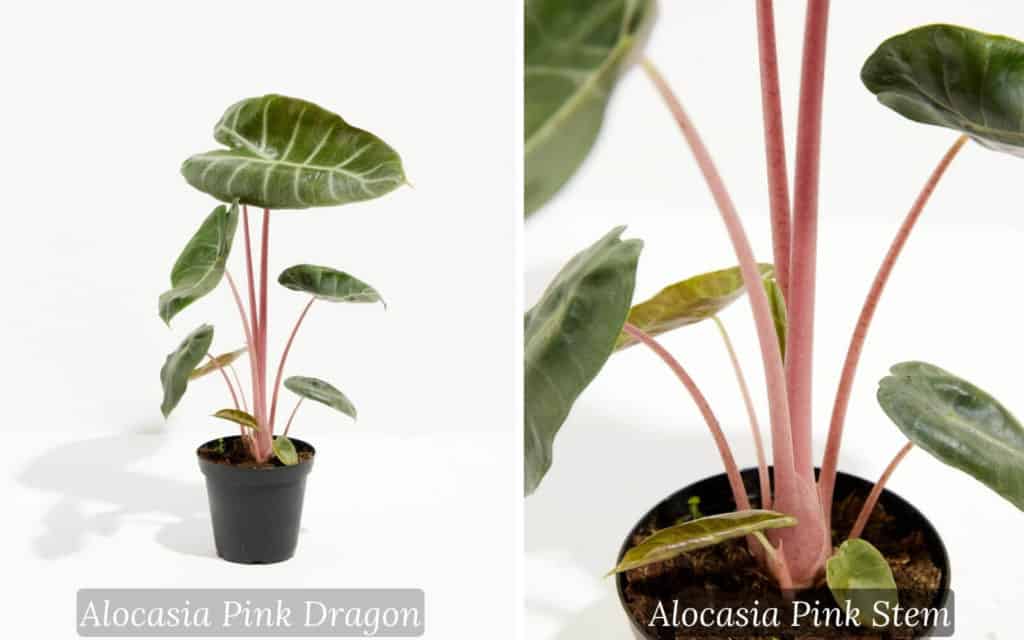
Temperature
Alocasia is a suitable plant for growing in any indoor space as long as it’s getting some indirect light and the room temperature remains between 64°F to 86°F (18°C to 30°C). It can bear a slightly cold winter season. However, the chilly indoor temperature isn’t its preferred environment.
You should move it indoors in winter if the outside temperature drops below 60°F (15°C). Keep it away from direct exposure to a heating vent or air conditioner to maintain a suitable growing temperature.
Humidity
The ideal humidity level for alocasia is 60% or more, but it can survive in drier areas. Placing a humidifier may be a good idea if you live somewhere that is drier than average or use a pebble tray. You can also regularly mist the plant to increase the humidity, but don’t let leaves drench with water.
Maintaining proper air circulation in the room ensures a good level of moisture that helps keep bright-looking leaves. You should avoid a drastic change in room temperature as it may bring shock to the plant that results in leaves wilting or falling off.
Fertilizer
During alocasia’s growing season (spring and summer), you can apply fertilizer once each month. Using a well-balanced fertilizer is the best option. When alocasia enters dormancy in fall, don’t fertilize it any longer.
Ensure that you don’t overwater or overfeed the plants throughout the dormant period and refrain from propagating or pruning.
Repotting
Should your pink dragon alocasia plant thrive at its current size, repot it only every couple of years. If the root system becomes too extensive or root-bound, you should repot the plant. Spring and summer is the best time for repotting.
Use a fresh potting mix soil and add some compost. It helps the root grow stronger and healthier to support the plant’s new growth.
Pruning
Pruning of alocasia isn’t needed as it only grows few leaves at a time. But if you see old leave has fallen off and the stems remain, you can prune that portion. You should also prune any damaged or infected parts to prevent disease spread.
Alocasia Pink Dragon comparison with similar plants
Alocasia pink dragon vs. Polly
Alocasia polly is a tropical plant with thick, odd-shaped strappy green leaves with prominent bright nerves. Pink dragon has much softer leaf edges than the alocasia polly and has a stem with a light shade of pink.
Alocasia pink dragon vs. pink princess
Pink princess is a vining plant that can grow up to 25 inches tall. It has pink or dark green leaves that can be variegated. The pink color is due to the lack of chlorophyll in leaves.
Alocasia has far bigger leaves than a pink princess and a tall smooth stem containing single leaves each stem. Due to the large leaf size, alocasia is also known as the elephant’s ear.
Alocasia pink dragon vs. Morocco
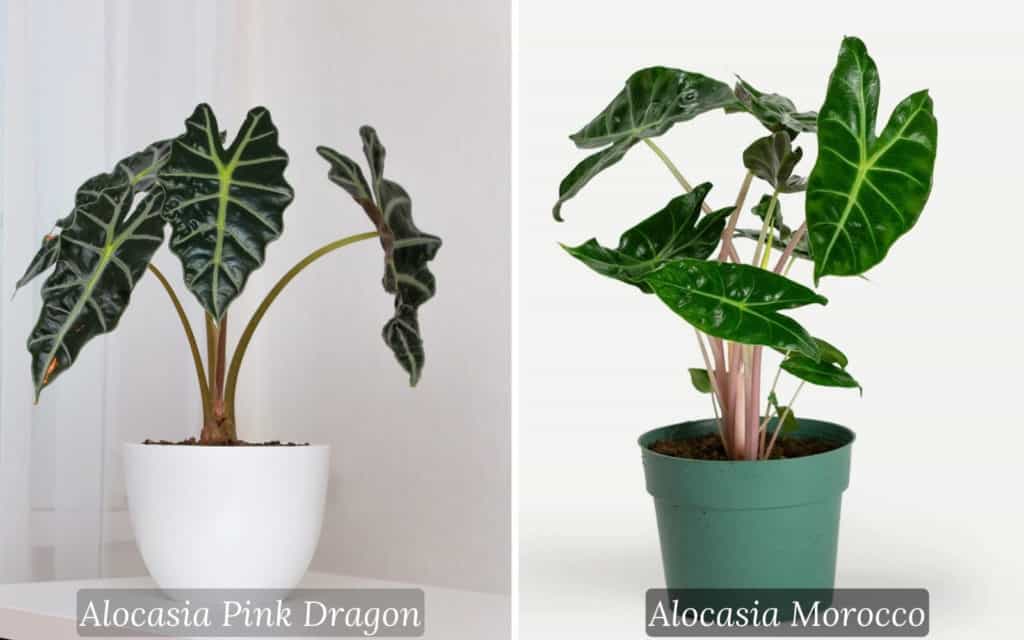
It can sometimes be difficult for people to differentiate Alocasia Morocco pink dragon from the Alocasia Pink dragon plant.
However, each of them is considered a species of Alocasia Iowii. The same plant is often marketed under both names, implying that there are two variations of this plant.
Alocasia ivory coast vs. Pink Dragon

The leaves of the Alocasia ivory coast have very prominent deep veins, while the broad leaf of pink dragon plants is very subtle.
While the Ivory coast plants have a pale green ring around their stems, pink dragon plants or even alocasia baginda silver dragon leaves have a circumferential green color surrounding the entire stem.
How to propagate Alocasia Pink Dragon
Pink stem alocasia typically sprouts from the central rhizome, which is undesirable as they won’t grow new roots. The easiest way to propagate the alocasia pink dragon is by separating the root growth clump and planting it in soil or water.
You will need to dig out the plant and remove excess soil from the root to get started. Carefully inspect the bulb and identify a healthy clump from the root system.
Use a trimming scissor to separate a single clump and plant it in a new planter. Ensure the rhizome remains stands upright and add some soil around it to stabilize it.
Water the soil and place it where it can get indirect light in a humid environment. Regularly water the pot to keep the soil moist, and you can apply light fertilizer to encourage growth.
Spring is the best time for propagation. After the plant has established roots, you can either transplant it outdoor in the garden or move it to a bigger pot.
What are the common pests, diseases, and other issues
Alocasia silver dragon is a sturdy plant, but it’s not entirely pest-resistant. You have to take proper care to ensure it remains healthy and can last several years.
These plants’ common issues include leaf spots, stem rot, spider mites, scale, and thrips. Prevent these problems by maintaining clean soil, appropriate humidity, and a dust-free environment.
You should treat the spread of infection by carefully isolating diseased plants and treating the leaves and stem using insecticide and fungicide such as neem oil (Amazon link).
You should also prune any infected or damaged parts and change the soil. Disinfect the container to prevent the disease spread and check for any new plants brought home from the store.
Here are some common issues that you may encounter with alocasia:
Yellowing Leaves: The yellow or pale leaves usually sign that the plant is overwatered. Check the soil to ensure it’s not soggy, and the roots aren’t soaked in standing water at the bottom of the container.
Dropping leaves: Check the temperature inside the room if you find rapid leaf loss. Ensure the temperature isn’t dropping too low or high. In the summer, ensure you don’t place it near the air conditioner or around the heating vent during the winter.
Sometimes when you change the plant location to bright indirect light, the leaf drops as it tries to adjust to the new environment. This shouldn’t cause concern, and wait for fresh leaves to sprout after a few days.
Wilting stems: You may need to support the delicate stems of this ornamental plant to hold overgrown leaves. Use a stake such as peat moss pole to help the plant.
Alocasia’s slow growth rate: There could be several reasons for the slow growth rate. Ensure you’re providing a suitable environment such as moist soil, indirect sunlight, and good water with some fertilizer.
If the ground is compact, loosen dry soil to allow air and water to reach the plant roots.
Excessive leave sweating: This is also known as guttation, where the excessive tiny moisture droplet appears on the leaf’s surface. This shouldn’t be concerning as it’s a tropical plant, and it evaporates the excess moisture through the transpiration process.
You should check your watering schedule as it may signify that you need to spread out further. Practicing good plant hygiene and tracking the plant’s reaction to environments and other factors can help prevent ailment and keep plants healthy.
How much does alocasia pink dragon cost?
Thanks to the recent boom in alocasia pink dragon popularity, you can find this exotic-looking plant all over the internet. While Alocasia Pink Dragon costs $20 to $125, a few rare species are available that can sell for much more than this.
Where to buy alocasia pink dragon?
Alocasia pink dragon is a rare plant and very trend these day causing increase in the demand. Often local garden stores sell out when it comes in stock. The best place to buy is through online retailers such as Etsy and Amazon, where you can find alocasia pink dragon for sale.
While some sellers guarantee their plants, others don’t. Before buying plants online, check the seller’s review. I prefer to find a seller with reviews that average 4 or 5 stars.
Also, know the shipping time and return policy of the store you’re buying from. If you can’t get your money back, you could have a dead plant with no refund.
Is Alocasia Pink Dragon toxic?
Yes, this is a mildly toxic plant, and experts advise keeping it away from children and pets, so they don’t chew on the leaves. Significant ingestion of any plant part could cause skin rashes, eye irritation, and swelling inside the mouth.
Although these aren’t very serious conditions, but can cause discomfort. You should consult a doctor if symptoms appear to be serious.
Conclusion
In conclusion, the Alocasia Pink Dragon is a beautiful houseplant easy to grow and maintain at a warm temperature. It comes in various colors, but the flowers are ordinary. If you’re looking for an easy-care plant for your garden, this is a great plant to have.
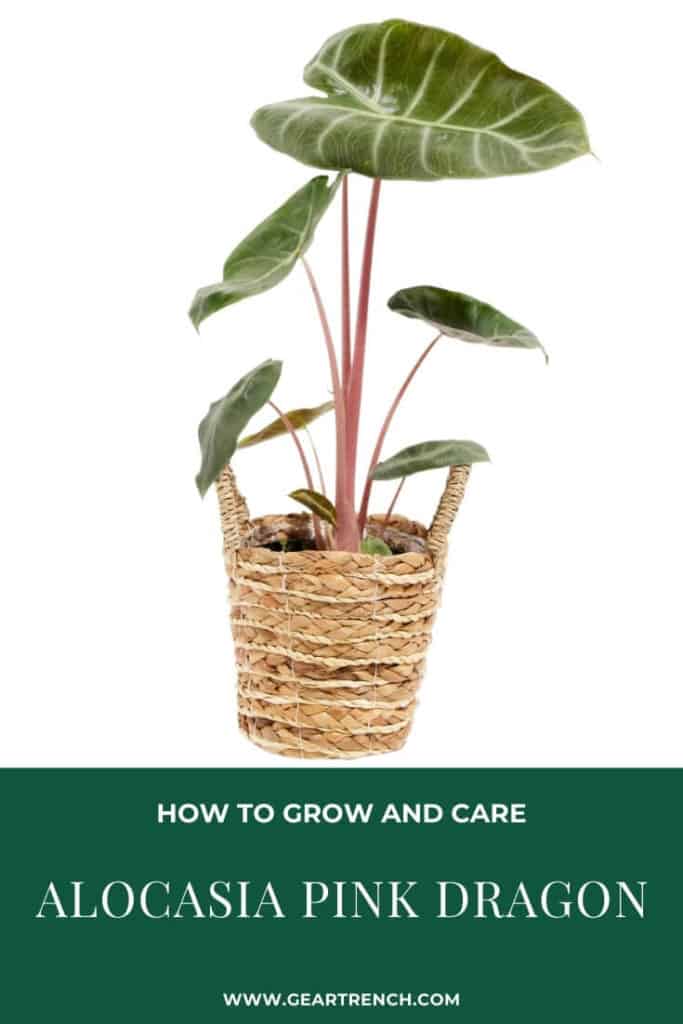
Don’t forget to share this post



